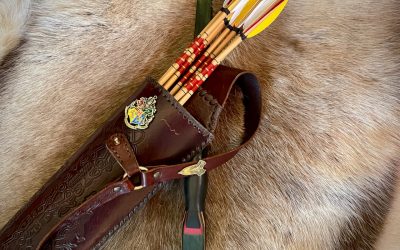Part 1. in the series of different draws
The draw is the soul of archery—the motion that bridges the archer’s strength and precision with the bow’s potential power. While often overlooked by casual observers, the way an archer draws their bow is steeped in history, cultural identity, and functional purpose. Across centuries and continents, different draw techniques have emerged, each reflecting the unique needs, traditions, and technologies of the societies that practiced them.
Let’s delve into some of the most enduring and significant draw styles, their historical and geographical origins, and the benefits and challenges they bring to the modern archer.
The Mediterranean Draw
History and Geography
The Mediterranean draw is perhaps the most universal of all techniques, with its origins rooted in ancient European and Middle Eastern cultures. This draw can be seen depicted in classical Greek and Roman art and was a staple of medieval European longbowmen. Its universality is linked to its simplicity and effectiveness, making it ideal for war, hunting, and sport.
Technique
The archer places their index finger above the arrow while the middle and ring fingers grip the string below it. This configuration ensures a balanced hold on the string and precise control of the arrow.
Upsides
-
- Offers a stable and consistent release.
- Compatible with both modern recurve bows and traditional longbows.
- Easy to learn and widely taught in contemporary archery disciplines.
Downsides
-
- Can place strain on the fingers without protective gear like a tab or glove.
- Less effective with high-draw-weight bows, which can make extended use uncomfortable.
The Three-Finger Under Draw
History and Geography
Known as the “Apache draw” in some traditions, this technique has been used in various indigenous cultures across the Americas and by European barebow shooters. Its popularity in modern times is closely tied to instinctive archery, where precision is valued over aiming systems.
Technique
All three fingers (index, middle, and ring) grip the string below the arrow. This setup provides a cleaner shot path as the arrow aligns closer to the eye, aiding in instinctive aiming.
Upsides
-
- Simplifies aiming for short-range shooting by aligning the arrow with the eye.
- Reduces finger strain compared to the Mediterranean draw.
Downsides
-
- Can be less stable for longer shots due to reduced string balance.
- Not ideal for high-powered bows requiring significant draw strength.
The Thumb Draw
History and Geography
The thumb draw is the hallmark of traditional Asian archery, appearing in Mongolian, Chinese, Korean, and Persian cultures. This technique was perfected by mounted warriors who needed a swift and powerful draw. Thumb rings, often ornately crafted, were used to protect the thumb and enhance the release, symbolising both utility and status.
Technique
The archer hooks the string with their thumb, securing it with the index or middle finger for support. The bow is often held horizontally or slightly canted, a style well-suited to horseback shooting.
Upsides
-
- Enables a strong and efficient draw, even with powerful composite bows.
- Ideal for mounted or rapid shooting due to its smooth release.
- The use of thumb rings reduces strain and ensures consistency.
Downsides
-
- Requires training and practice to master, especially the use of a thumb ring.
- Risk of injury or discomfort if performed incorrectly.
The Pinch Draw
History and Geography
The pinch draw is one of the oldest techniques in archery, used by early humans with primitive bows. It is frequently depicted in ancient cave paintings and artefacts, showing its simplicity and universality.
Technique
The archer pinches the arrow and string between their thumb and index finger, drawing the bow back without any additional finger support.
Upsides
-
- Extremely simple and intuitive, requiring no training or equipment.
- Ideal for primitive bows with low draw weights.
Downsides
-
- Offers limited power and accuracy, as the grip lacks stability.
- Ineffective with modern or high-powered bows.
The Slavic Draw
History and Geography
The Slavic draw is an Eastern European technique with deep roots in traditional archery. While not as widespread as the Mediterranean or thumb draws, it remains a fascinating example of regional variation in archery practices.
Technique
In this method, the archer places the index finger below the arrow while the middle and ring fingers grip the string above it. This arrangement creates a distinct grip and release style.
Upsides
-
- Provides a unique balance for archers accustomed to this technique.
- A cultural hallmark for those practicing traditional Slavic archery.
Downsides
-
- Less effective with modern bows or for precision shooting.
- Rarely taught, making it difficult to find resources or instruction.
The Japanese (Kyudo) Draw
History and Geography
The Japanese draw is central to Kyudo, the “Way of the Bow,” a martial art deeply intertwined with Zen philosophy. Originating in Japan, Kyudo evolved from the martial techniques of samurai archers to a spiritual and meditative practice.
Technique
Kyudo archers use a unique grip on the bowstring, relying on the entire hand rather than individual fingers. The draw is a ritualistic process, performed with deliberate precision and mindfulness, reflecting the discipline’s spiritual aspects.
Upsides
-
- Embodies a meditative and holistic approach to archery.
- Suitable for ceremonial and traditional practices.
Downsides
-
- Requires specialised training and equipment, including the asymmetrical Japanese bow (yumi).
- Not intended for practical or competitive use in modern contexts.
Conclusion
Each draw technique carries its own story, shaped by the environment, culture, and purpose it served. From the Mediterranean draw’s dominance in Western traditions to the thumb draw’s legacy in mounted warfare, these methods highlight the ingenuity of archers across history. While some techniques remain vital to modern sport and hunting, others are treasured for their cultural significance and artistry.
Choosing the right draw depends on the archer’s goals, equipment, and personal preferences. Whether you aim to honour a tradition or achieve precision in competition, understanding these draws enriches your connection to the timeless craft of archery.





0 Comments